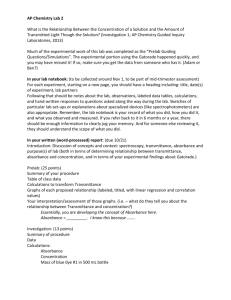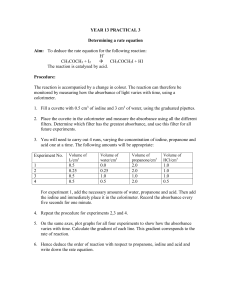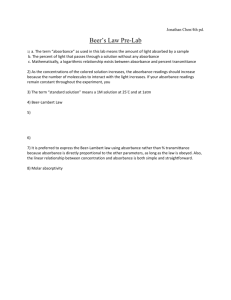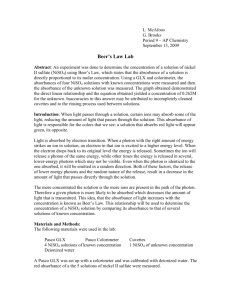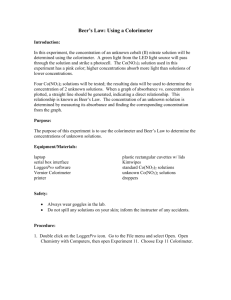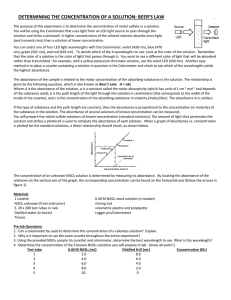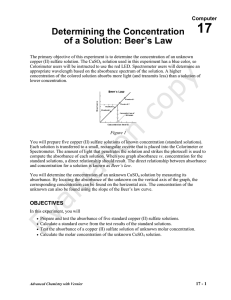The Beer-Lambert Law
advertisement
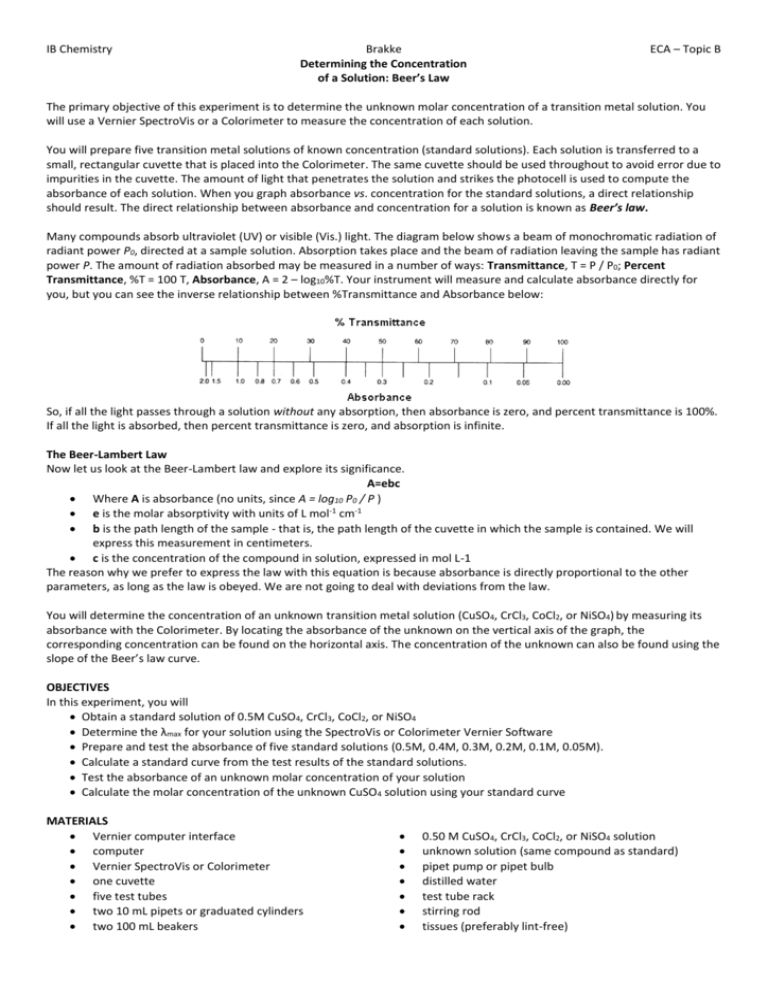
IB Chemistry Brakke Determining the Concentration of a Solution: Beer’s Law ECA – Topic B The primary objective of this experiment is to determine the unknown molar concentration of a transition metal solution. You will use a Vernier SpectroVis or a Colorimeter to measure the concentration of each solution. You will prepare five transition metal solutions of known concentration (standard solutions). Each solution is transferred to a small, rectangular cuvette that is placed into the Colorimeter. The same cuvette should be used throughout to avoid error due to impurities in the cuvette. The amount of light that penetrates the solution and strikes the photocell is used to compute the absorbance of each solution. When you graph absorbance vs. concentration for the standard solutions, a direct relationship should result. The direct relationship between absorbance and concentration for a solution is known as Beer’s law. Many compounds absorb ultraviolet (UV) or visible (Vis.) light. The diagram below shows a beam of monochromatic radiation of radiant power P0, directed at a sample solution. Absorption takes place and the beam of radiation leaving the sample has radiant power P. The amount of radiation absorbed may be measured in a number of ways: Transmittance, T = P / P0; Percent Transmittance, %T = 100 T, Absorbance, A = 2 – log10%T. Your instrument will measure and calculate absorbance directly for you, but you can see the inverse relationship between %Transmittance and Absorbance below: So, if all the light passes through a solution without any absorption, then absorbance is zero, and percent transmittance is 100%. If all the light is absorbed, then percent transmittance is zero, and absorption is infinite. The Beer-Lambert Law Now let us look at the Beer-Lambert law and explore its significance. A=ebc Where A is absorbance (no units, since A = log10 P0 / P ) e is the molar absorptivity with units of L mol-1 cm-1 b is the path length of the sample - that is, the path length of the cuvette in which the sample is contained. We will express this measurement in centimeters. c is the concentration of the compound in solution, expressed in mol L-1 The reason why we prefer to express the law with this equation is because absorbance is directly proportional to the other parameters, as long as the law is obeyed. We are not going to deal with deviations from the law. You will determine the concentration of an unknown transition metal solution (CuSO4, CrCl3, CoCl2, or NiSO4) by measuring its absorbance with the Colorimeter. By locating the absorbance of the unknown on the vertical axis of the graph, the corresponding concentration can be found on the horizontal axis. The concentration of the unknown can also be found using the slope of the Beer’s law curve. OBJECTIVES In this experiment, you will Obtain a standard solution of 0.5M CuSO4, CrCl3, CoCl2, or NiSO4 Determine the λmax for your solution using the SpectroVis or Colorimeter Vernier Software Prepare and test the absorbance of five standard solutions (0.5M, 0.4M, 0.3M, 0.2M, 0.1M, 0.05M). Calculate a standard curve from the test results of the standard solutions. Test the absorbance of an unknown molar concentration of your solution Calculate the molar concentration of the unknown CuSO4 solution using your standard curve MATERIALS Vernier computer interface computer Vernier SpectroVis or Colorimeter one cuvette five test tubes two 10 mL pipets or graduated cylinders two 100 mL beakers 0.50 M CuSO4, CrCl3, CoCl2, or NiSO4 solution unknown solution (same compound as standard) pipet pump or pipet bulb distilled water test tube rack stirring rod tissues (preferably lint-free) IB Chemistry Brakke ECA – Topic B PROCEDURE 1. Obtain and wear goggles. These materials are toxic; handle with care and dispose of properly! 2. Obtain 0.5M solution of CuSO4, CrCl3, CoCl2, or NiSO4 from Mr. Brakke 3. Label four clean, dry, test tubes 1-4. Use pipets to prepare five standard solutions according to the chart below. Thoroughly mix each solution with a stirring rod. Clean and dry the stirring rod between uses. Trial Concentration 0.50 M CuSO4 Distilled H2O number (M) (mL) (mL) 1 2.00 8.00 0.10 2 4.00 6.00 0.20 3 6.00 4.00 0.30 4 8.00 2.00 0.40 5 10.00 0.00 0.50 4. 5. 6. 7. Connect a SpectroVis directly to the computer or Colorimeter to the goLink adapter. Connect the adapter to the computer using the proper cable. Start the Logger Pro program on your computer. Calibrate the Colorimeter. a. Fill a cuvette about ¾ full with distilled water and place it in the cuvette holder. Align the cuvette so a clear side of the cuvette is facing the light source. b. Choose Calibrate USB:Spectrometer from the Experiment Menu. Follow the instructions in the dialog box to complete the calibration, and then click OK. You are now ready to collect absorbance-concentration data for the five standard solutions a. Fill a cuvette about ¾ full of the 0.5M solution. Place the sample in the cuvette slot of the SpectroVis. b. Start the data collection. Watch the values at each wavelength and note the wavelength of maximum absorbency. Tap on the red Stop button to end the data collection. This will be your λ max which is the wavelength that will be most effective in continuing your experiment. BE SURE TO SAVE A COPY OF THIS IMAGE FOR YOUR LAB WRITE UP. c. Click on the configure spectrometer Data Collection button. d. Select Abs v. Concentration as the collection mode. The wavelength of maximum absorbance (λmax) should be automatically selected. Click OK to continue or click clear and select a wavelength on the graph or in the list of wavelengths. e. Place your first transition metal complex solution into the cuvette again. Click “collect.” After the absorbance reading stabilizes, click “keep.” Enter the concentration of the solution and select OK. f. Repeat step 5 for the remaining standard samples. After you have tested the final standard, tap the red “Stop” button to end the data collection. g. You may calculate the best fit line equation for your standards from the analyze menu. YOU WILL NEED TO ALSO PRODUCE YOUR OWN DATA TABLES AND GRAPH IN EXCEL. BUT BOTH CAN BE INCLUDED IN YOUR LAB IF NECESSARY. h. Place a cuvette containing an unknown sample of solution in the SpectroVis. Once again, you may chose the method from the logger pro (Interpolation Calculator from the analyze menu) to display the absorbance and concentration values, BUT YOU MUST CALCULATE THIS ON YOUR OWN FOR YOUR LAB WRITE UP!! In your final write up, you are graded on DCP and CE. No intro needed, just a title. DO NOT CUT AND PASTE THIS LAB INFO, PROCEDURES, ANYTHING INTO YOUR LAB as it makes it cluttered and provides far too much info for what you are reporting on. You are to include ALL raw data for the determination of λmax ALL raw data for each experiment You should run two full trials. Do it all, and then a second time. ALL data should include uncertainty values A table with any and all equations used ALL processed data, concentrations, averages, slope of absorbance line, etc A chart demonstrating Abs vs Wavelength for the strongest absorbance A graph of Abs vs concentration with a best fit line including error bars and your unknown extrapolation An explanation for every table or chart A complete conclusion (beginning with results stated clearly) An evaluation of your lab (including an error analysis) Any and all improvements that can be made



